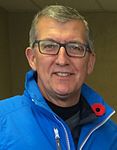| |||||||||||||||||||||||||||||||||||||||||||||||||||||
All 40 seats in the 48th General Assembly of Newfoundland and Labrador 21 seats needed for a majority | |||||||||||||||||||||||||||||||||||||||||||||||||||||
|---|---|---|---|---|---|---|---|---|---|---|---|---|---|---|---|---|---|---|---|---|---|---|---|---|---|---|---|---|---|---|---|---|---|---|---|---|---|---|---|---|---|---|---|---|---|---|---|---|---|---|---|---|---|
| Opinion polls | |||||||||||||||||||||||||||||||||||||||||||||||||||||
| Turnout | 55.2%[1] | ||||||||||||||||||||||||||||||||||||||||||||||||||||
| |||||||||||||||||||||||||||||||||||||||||||||||||||||
 Popular vote by riding. As this is an FPTP election, seat totals are not determined by popular vote, but instead via results by each riding. | |||||||||||||||||||||||||||||||||||||||||||||||||||||
| |||||||||||||||||||||||||||||||||||||||||||||||||||||
The 2015 Newfoundland and Labrador general election, held on November 30, 2015, elected members of the 48th General Assembly of Newfoundland and Labrador. The Progressive Conservative Party which had governed since 2003 election, was defeated by the Liberal Party, which won a majority in the new assembly.[2][3][4][5]
The election had been scheduled for October 13, 2015, under Newfoundland and Labrador's House of Assembly Act, mandating a fixed election day on the second Tuesday in October in the fourth calendar year after the previous election. However, the House of Assembly amended the act in June 2015, to delay the election until November 30, 2015, so that the election campaign would not overlap with the federal election scheduled on October 19, 2015.[6]
Following the result of the election no party with the word "Conservative" in its name formed the government in either a provincial or federal jurisdiction in Canada for the first time since 1943.[7][8]
At the time --with 55.2% of eligible voters casting a ballot -- this election had the lowest turnout of any provincial election since confederation. This record was broken in 2021 when only 48.24% of eligible voters cast a ballot.[9]
- ^ "Record-low voter turnout seen as a huge problem". CBC News. Archived from the original on September 17, 2020. Retrieved May 16, 2019.
- ^ "Dunderdale leads N.L. Tories to majority". Canadian Broadcasting Corporation. October 12, 2011. Archived from the original on February 25, 2012. Retrieved October 15, 2011.
- ^ "Dwight Ball, new Liberal cabinet sworn in at Government House". CBC News. December 14, 2015. Archived from the original on January 23, 2022. Retrieved June 9, 2017.
- ^ "4 Tory cabinet ministers fall to defeat in Liberal rout". CBC News. December 1, 2015. Archived from the original on January 25, 2022. Retrieved April 3, 2016.
- ^ "Outsiders like Crosbie, Wakeham only hope for PC Party rebuild, says political scientist". CBC News. December 4, 2017. Archived from the original on October 26, 2021. Retrieved May 14, 2018.
- ^ "Provincial election set for Nov. 30". Canadian Broadcasting Corporation. June 8, 2015. Archived from the original on June 10, 2015. Retrieved June 18, 2015.
- ^ Coyne, Andrew (December 2, 2015). "Andrew Coyne: Conservatives need rebirth before they can rebuild". National Post. Retrieved December 4, 2015.
- ^ Cosh, Colby (November 10, 2015). "Colby Cosh: Is conservatism on the way out?". National Post. Retrieved December 4, 2015.
- ^ "'Turnout is a real story' of Newfoundland and Labrador election | SaltWire". Archived from the original on September 29, 2021. Retrieved September 29, 2021.

